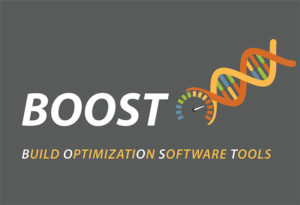Improve on existing biological computer-aided design and manufacture (bioCAD/CAM) tools
 The Science
The Science
Synthetic DNA allows scientists to expand the breadth and depth of their genomic research. In this study researchers from the U.S. Department of Energy Joint Genome Institute (JGI) have developed a suite of build-optimization software tools (BOOST) to streamline the design-build transition in synthetic biology engineering workflows. BOOST can automatically detect “difficult” sequences (of nucleotides) and redesign them for DNA synthesis, addressing DNA sequences with certain problematic characteristics (e.g., extreme %GC, sequence patterns, and repeats), which decrease the success rate of DNA synthesis.
The Impact
By improving the design and manufacture of synthetic DNA through enhanced tools, scientists can accelerate gene discovery and gene characterization toward practical applications for energy and the environment.
Summary
The ability to design and manufacture synthetic DNA has opened tremendous possibilities in genomic research. In addition to providing access to samples that are hard to find in nature (as well as crafting genomic sequences not known to occur in the natural world), manufacturing DNA enables scientists to test any sequence in a wide variety of contexts and environments. BioCAD/CAM software tools help researchers design sequences that can be critical to discovering new solutions for energy and the environment, but so far the software has not been able to automatically fix problematic sequences. This slows down the transition from the design to the manufacturing process that delays the synthesis of designed DNA.
To solve this problem, researchers at the JGI, a DOE Office of Science User Facility, developed a suite of build-optimization software tools (BOOST) to automate the synthetic DNA design process—and do away with the trial-and-error process scientists currently utilize to determine a sequence that can be synthesized.
“The goal of BOOST is to streamline, in a scalable fashion, the process of designing readily synthesizable DNA fragments,” the team wrote in a paper published on December 6, 2016 in ACS Synthetic Biology that detailed BOOST’s capabilities. The suite of tools is available as a web application, an executable JAVA Archive (JAR), and as a RESTful API. Ultimately, this will accelerate the use of synthetic DNAs to explore gene functions relevant to DOE’s energy and environmental missions.
Contacts
Daniel Drell, Ph.D.
Program Manager
Biological Systems Sciences Division
Office of Biological and Environmental Research
Office of Science
US Department of Energy
[email protected]
Ernst Oberortner
DOE Joint Genome Institute
[email protected]
Funding
- U.S. Department of Energy Office of Science
Publications
- E. Oberortner, J.F. Cheng, N.J. Hillson, and S. Deutsch, “Streamlining the Design-to-Build Transition with Build-Optimization Software Tools.” ACS Synth. Biology, (2016) doi:10.1021/acssynbio.6b00200